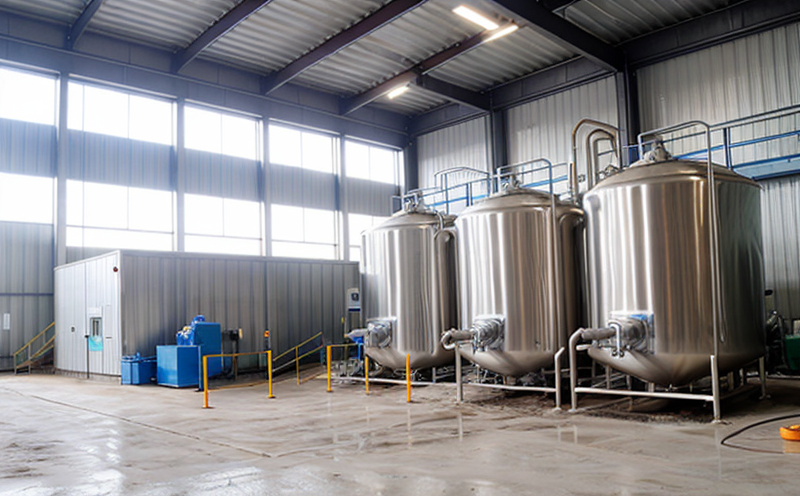APHA 4500 NO2 Nitrite Test in Process Water
The APHA 4500 NO2 Nitrite test is a critical measurement used to ensure compliance with water quality standards and safeguard industrial processes. Nitrite, a toxic form of nitrogen found in process waters, can have severe implications on both the environment and human health if not properly managed. In industrial settings, nitrite contamination can arise from various sources including chemical reactions within the process itself or through external pollutants such as runoff from agricultural activities.
Understanding the presence and concentration levels of nitrite is essential for maintaining optimal operational conditions that prevent equipment corrosion, biofilm formation, and other detrimental effects on piping systems. Moreover, it helps in identifying potential risks associated with discharge into municipal sewers which could lead to violations of local regulations or permit limits. This testing procedure adheres strictly to internationally recognized methods outlined by the American Public Health Association (APHA), ensuring accuracy and reliability.
The APHA 4500 NO2 Nitrite test involves several steps including sample collection, filtration if necessary, dilution according to specified concentrations, preparation of reagents, color comparison using a standard chart or spectrophotometer, and finally recording results. The choice between manual visual assessment against printed charts versus automated optical analysis depends largely on the facility's resources and preference for precision over speed.
By implementing this test regularly as part of routine monitoring protocols, industries can proactively address issues before they escalate into costly problems. Regular testing not only ensures adherence to regulatory requirements but also contributes towards creating safer working environments by minimizing exposure risks for employees handling potentially hazardous materials.
In summary, the APHA 4500 NO2 Nitrite test serves as an indispensable tool in safeguarding industrial processes while promoting sustainable practices that protect both human health and ecosystems. Its importance cannot be overstated given its role in preventing adverse impacts on water quality standards.
Why It Matters
The APHA 4500 NO2 Nitrite test is crucial for ensuring safe and efficient industrial processes by providing accurate measurements of nitrite levels within process waters. High concentrations of nitrite can lead to several undesirable outcomes such as increased corrosion rates, reduced chemical stability, and even damage to sensitive equipment.
- Increased Corrosion Rates: Excessive nitrite content may accelerate the degradation rate of metallic components used in various industrial applications, leading to premature failures and costly repairs.
- Reduced Chemical Stability: Nitrites can react with other chemicals present in process waters, forming unstable compounds that could compromise overall system performance.
- Potential Equipment Damage: Over time, continuous exposure to high levels of nitrite might result in physical damage to pipes, valves, and other infrastructure elements, necessitating frequent maintenance or replacements.
Furthermore, compliance with relevant environmental regulations is paramount for any organization operating within the water and wastewater sector. Failure to monitor and control nitrite concentrations could result in severe financial penalties due to non-compliance fines or operational shutdown orders from regulatory bodies.
In conclusion, regular implementation of the APHA 4500 NO2 Nitrite test enables businesses to maintain optimal operational conditions, enhance product quality, reduce risks associated with environmental harm, and ultimately contribute positively towards sustainability goals.
Benefits
- Promotes Safe Operations: By accurately measuring nitrite concentrations, the APHA 4500 NO2 Nitrite test ensures that industrial processes operate within safe limits, protecting both personnel and equipment from potential hazards.
- Enhances Product Quality: Maintaining appropriate nitrite levels helps prevent degradation of end products, thereby enhancing their shelf life and marketability.
- Fosters Compliance: Regular testing ensures adherence to local, national, and international environmental standards, reducing the likelihood of costly fines or legal actions.
- Reduces Risk: Early detection allows for timely interventions, mitigating risks associated with nitrite-related incidents such as spills or leaks.
The APHA 4500 NO2 Nitrite test also facilitates better resource management by optimizing water usage and minimizing waste generation. It supports informed decision-making processes regarding process adjustments and necessary corrective actions aimed at maintaining optimal performance throughout the lifecycle of industrial facilities.
Use Cases and Application Examples
| Industry Sector | Specific Process | Purpose of Testing | Results Impact |
|---|---|---|---|
| Agricultural Processing | Cleaning Solutions Manufacturing | Detect nitrite residuals in cleaning agents to ensure product safety and effectiveness. | Ensures compliance with food safety regulations, enhances quality control measures. |
| Mining | Waste Management Systems | Monitor effluent discharge for excess nitrite content before release into water bodies. | Avoids pollution fines and improves public image through responsible waste disposal practices. |
| Petrochemical | Chemical Synthesis | Control nitrite levels during synthesis reactions to optimize yield and purity of final products. | Increases efficiency, reduces energy costs, and ensures product quality meets industry standards. |
| Pharmaceuticals | Product Formulation | Verify nitrite content in raw materials used during formulation stages to meet strict regulatory requirements. | Guarantees adherence to Good Manufacturing Practices (GMP), protecting consumer health and safety. |
The APHA 4500 NO2 Nitrite test finds application across diverse industries where process waters are involved. Its primary purpose is to ensure that nitrite concentrations remain within acceptable limits, thereby promoting safer operations, enhancing product quality, fostering compliance, and reducing risks.





